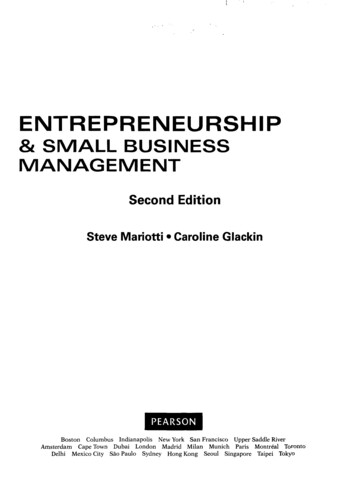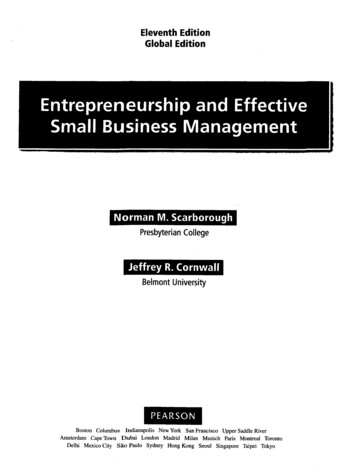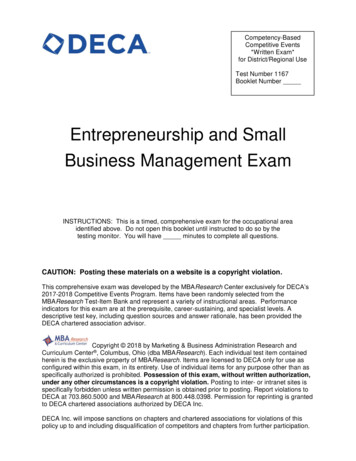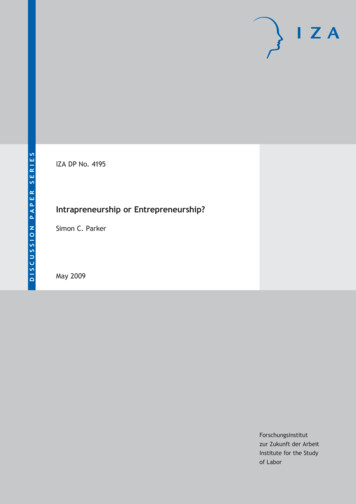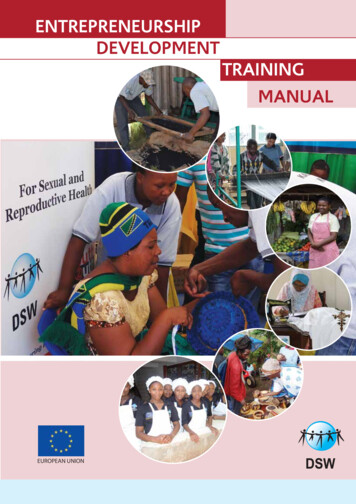
Transcription
ENTREPRENEURSHIPDEVELOPMENTTRAININGMANUALEUROPEAN UNION
Entrepreneurship Development Training ManualENTREPRENEURSHIP DEVELOPMENTTRAINING MANUAL1
Entrepreneurship Development Training ManualForeword and acknowledgementDSW (Deutsche Stiftung Weltbevoelkerung) is an international development and advocacyorganisation founded in 1991 as a non-profit foundation in Hannover, Germany. Its workcentres on development programmes, advocacy, and awareness-raising with a focus onachieving universal access to sexual and reproductive health and rights (SRHR), which isfundamental to improving health and fighting poverty. With headquarters in Hannover,Germany, DSW maintains four country offices in Ethiopia, Kenya, Tanzania, and Uganda,as well as liaison offices in Berlin, Germany, and Brussels, Belgium.DSW empowers young people and communities in low and middle-income countries byaddressing the issues of population dynamics and health as a way to achieve sustainabledevelopment. Our focus is on achieving universal access to sexual and reproductive healthservices and information, which is fundamental to improving health and effectively fightingpoverty.DSW has been providing quality, needs-based entrepreneurship training to young people,women, trainers and middle-level professionals in its operation areas mainly in EasternAfrica (Ethiopia, Kenya, Tanzania and Uganda). This has necessitated the development of thisEntrepreneurship Training Manual which has been harmonised for use by different targetgroups in the region, courtesy of the “Working Together for Decent Work” Project funded bythe European Union (EU). This manual has been adopted from DSW’s entrepreneurshiptraining manuals and other key manuals including the International Labour Organisation(ILO) business development training manuals and handbooks, DSW’s Income GeneratingActivity (IGA) management training manuals and other relevant sources. The overall goal ofthis manual is to equip trainers, civil society organisations, community-based organisations,youth leaders, as well as other partners with the basic concepts of entrepreneurship andknowledge of business planning essential for the success of an entrepreneur involved insmall business.The modules of this manual can be delivered as a complete package or appropriately selectedbased on the specific training needs of the intended participants. The manual has beenwritten in simple language to ease understanding, and adapted to trainees of different levelsand needs. It can thus be used to train diverse groups particularly as the facilitator isat liberty to decide which activities are most relevant to the different groups and has theflexibility to adapt various activities to ensure relevance in the local context.The development of this manual is a major success for DSW’s work in empowering womenand youth in the informal sector and we hope that you will find it useful.Ulrike NeubertDSW Director Programmes and Projects2
Entrepreneurship Development Training ManualTable of ContentsForeword and acknowledgement.2Table of contents.31. Introduction to the manual.51.1 Objectives of the manual.51.2 For whom is this manual designed?.51.3 Approach.61.4 Structure.71.5 How to use this manual.7Module 1: Effective Facilitation.8Introduction .9Section 1: How to plan a participatory learning process.91.1 Basics.91.2 Preparatory activities and planning.10Section 2: Getting started.122. 1 Opening of the training workshop.132.2 Opening ceremony of the training workshop.132.3 Introduction of participants.142.4 Clarifying participants’ expectations and concerns.152.5 Understanding the overall objectives of the training.162.6 Agreeing on a time table.172.7 Ensuring a conducive environment and active participation.172.8 Reaching a consensus on training norms.21Section 3: How to conclude a participatory learning process. 223.1 Daily evaluation of the participatory learning process.223.2 Final evaluation at the end of the training and follow-up.243.3 Closing ceremony and participant certificates.25Section 4: Participatory learning and effective communication skills.264.1 Facilitating a participatory learning process.263
Entrepreneurship Development Training Manual4.2 Participatory methods, techniques and tools.28Module 2: Understanding Basic Concepts of Entrepreneurship.31Section 1: Definition of concepts.32Section 2: Qualities of an entrepreneur .342.1 Opportunity-seeking .342.2 Persevering. 342.3 Risk Taking.352.4 Demanding for efficiency and quality.362.5 Information-seeking.392.6 Goal setting.402.7 Planning.412.8 Persuasion and networking.412.9 Building self-confidence.422.10 Listening to others.432.11 Demonstrating leadership.43Module 3: Generating a Business Idea.48Module 4: Developing a Business Plan.59Section 1: Market analysis.62Section 2: Financial analysis.65Section 3: Realistic planning.70Module 5: Marketing.77Module 6: Costing and Pricing.84Module 7: Operational Management.90Module 8: Record-Keeping.102Module 9: Saving.110References.1174
Entrepreneurship Development Training Manual1. INTRODUCTION TO THE MANUAL1.1 Objectives of the manualThe overall objective of this manual is to equip trainers, civil society organisations,community-based organisations, youth leaders as well as other partners with the basicconcepts of entrepreneurship and knowledge of business planning essential to the successof the entrepreneur of a small business.Specifically, this manual is designed to help participants: Learn how to generate, identify and select business ideas Practice the preparation of a specific, comprehensive business plan tailored to eachindividual’s entrepreneurial needs. Explore the linkages between an entrepreneur and all the resources and services neededto successfully launch and sustain a small enterprise. Understand saving as a life skill for individual livelihood and business improvement.1.2For whom is this manual designed?Acknowledging the strength and effectiveness of peer learning, this DSW EntrepreneurshipDevelopment Training Manual is designed to ultimately strengthen, improve and effectivelyfacilitate entrepreneurial knowledge and skills gain of young people, women and professionalswho manage their own businesses.The manual is therefore designed to be used at four different levels: Training of trainers (TOTs) or Peer Educator Trainers (PETs) trainingsThe manual serves as a training tool which DSW staff will use to train trainers often referredto as Trainers of Trainers (TOTs) or Peer Educator Trainers (PETs). Each of these trainingworkshops can be structured and conducted in accordance with the sequence, contentand structure of this manual enabling TOTs/PETs to acquire all the necessary knowledge,information and skills that will enable them to conduct trainings for peer educators in turn. Peer educator trainingsIn the context of DSW’s work, peer educators are selected members of the active youth clubnetwork. They are trained by TOTs who facilitate each or selected modules of this manual(including Module 1) and ensure that knowledge, information as well as skills of effectivefacilitation are adequately passed on to peer educators. Peer learning group facilitationThe role of peer educators is to apply the facilitation skills they have acquired during theirtrainings in order to organise and conduct peer learning groups at the grass root level withtheir peers and group members. Their role is not necessarily to pass on these facilitationskills but to use them to create a conducive learning environment and to effectively transfer5
Entrepreneurship Development Training Manualknowledge and skills to the participants by means of interactive exercises. In this context,the manual serves both as a resource for entrepreneurial information and a reference guidefor topics and exercises during peer learning groups. Training women and professionals who manage their own businessesThe content of the manual shall be tailor made to suit the needs of additional target groupsincluding women’s groups and professionals. The facilitator shall ensure that a needsassessment is always conducted prior to structuring the training so as to know the knowledgelevels of the participants and their specific needs.1.3 ApproachThis Entrepreneurship Development Manual includes content on entrepreneurship as wellas training methodologies that enable effective facilitation, participatory and experientiallearning and thus lead to sustainable knowledge and skills gain of and for the intendedparticipants.Conventional learning with a teacher or trainer lecturing in front of a group has proven tobe less effective than learning approaches that actively engage participants in the learningprocess. This manual is therefore based on a participatory learning approach.Accordingly, the learning content is not passed on from the trainer to the participants in aone-way communication with trainees only listening. Instead, training participants areencouraged to discover learning contents themselves in an active process. Regardless of thelevel of formal education, each participant has a valuable contribution to make, if encouragedto be an active partner in the learning process.Based on this approach, in this manual, the trainer acts as and is referred to as a “facilitator”.He/she “facilitates” participatory and experiential learning, i.e., creates the conditions andthe environment in which trainees themselves will discover and practice knowledge and skills.By means of exercises, trainees will explore and share their own experience and knowledge,critically conceptualize and reflect upon solutions from which they will derive learningcontents and ways for practical“I never teach my pupils;implementation of an enterprise.Ionlyattempttoprovide the conditionsAppropriate activities and imagesin which they can learn”.included in the manual will supportAlbert Einsteinthe acquisition of knowledge and(German-US American physicist, 1879 – 1955).understanding of entrepreneurshipin a student-friendly way.Participatory methods and creative tools are employed throughout the modules, to facilitatelearning on entrepreneurial topics and other relevant contents. Moreover, as this manualaddresses TOTs or facilitators, it provides the participants with practical skills on howto effectively transfer knowledge and skills to others. Consequently, the manual not onlyelaborates on the theoretical and conceptual basics of participatory learning and behaviouralchange, but also on effective communication skills. It provides practical guidance on howto conduct a training workshop and includes methods and techniques that are needed toorganise and conduct training sessions based on the principle of participatory learning.6
Entrepreneurship Development Training Manual1.4 StructureThis manual is divided into nine modules.Module one constitutes the theoretical and conceptual backbone to understand theapproach, process and aim of participatory learning and effective facilitation. Moreover, itserves as a practical guide for facilitators and elaborates on how to prepare and facilitateentrepreneurship training and respective sessions based on the participatory learningapproach. As such, it outlines steps that need to be taken ahead or at the beginning of thetraining. Module one provides the groundwork based upon which all other Modules can befacilitated.Modules two to nine deal with different entrepreneurial-related topics focused on thepractical skills that entrepreneurs need to have to set up a successful enterprise. Themodules are designed to follow the participatory learning approach. Some are divided intosections consisting of various sub-sections (sessions) that focus on the educational contentsand topics related to the overall learning objectives of the module, as well as many practicalexamples.1.5 How to use this manualThis manual can be used in various ways.For the facilitation of TOTs it is recommended that trainers use this manual as a compactand holistic training outline and toolkit. It is designed to enable coherent five-day training ifeach module is worked through as outlined in the manual.However, the modular structure also provides for alternative ways to use this manual:following a needs-based analysis of entrepreneurial knowledge, facilitators can selectparticular modules and facilitate a tailor-made training for particular learning needs, e.g.developing a business plan only. Moreover, against the background of facilitation of peerlearning groups, the modular structure allows to spread out learning over several weeks ormonths, so that participants can learn at their convenience and relate the contents to theirreality. Eventually, it is up to the user and facilitator to decide how best to use the approachand information presented in this manual.7
Entrepreneurship Development Training ManualMODULE 1Effective Facilitation8
Entrepreneurship Development Training ManualIntroductionThis module introduces the concept and structure of participatory learning. It outlinesthe principles of effective facilitation and provides practical guidance for organisers andfacilitators of participatory learning sessions.The information presented in this module constitutes the backbone of a participatory learningprocess. Each of the following modules of the Entrepreneurship Development Manual isbased on the concepts and procedures introduced in this module. It is up to the facilitatorto decide whether to share the information included in Module 1 in form of participatorylearning and exercises as suggested in the relevant sections below, or to inform the trainingparticipants about the contents and the general concepts of facilitation and participatorylearning in form of a general introduction to the training. Section 1 of Module 1 focuses on the practical basics of how to effectively prepare,initiate and close a participatory training and essential steps for creating a conduciveenvironment while ensuring active participation of all trainees. Section 2 is dedicated to the roles and responsibilities that participants can take on in aparticipatory learning process, e.g. as facilitators for particular sessions or as evaluationsupervisors for daily activities. Section 3 explains the process and importance of evaluation. Every session, every dayand the training as a whole will be concluded with an evaluation. Frequent evaluationfosters mutual learning and helps to adapt to changes swiftly. It will also enable, intensifyand support the ongoing improvement of the participatory learning process. Section 4 focuses on basic theory and concepts of participatory learning and effectivefacilitation skills. It provides a comprehensive overview of special skills, methods andtechniques for successful learning as a toolkit for facilitators to organise and conducttraining sessions based on the principles of participatory learning.SECTION 1: HOW TO PLAN A PARTICIPATORY LEARNING PROCESS1.1 BasicsParticipatory learning requires a conducive learning environment. Before starting aparticipatory learning process on entrepreneurship, you need to consider a number ofimportant aspects and engage in various planning and preparatory activities.The participantsSince interests and capabilities differ, the facilitator should take a keen interest inunderstanding the needs and aspirations of the participants before actually conducting thetraining.The participants are volunteers. If they are not offered a conducive learning environment,they may walk away. In order to create a favourable environment, you should prepare9
Entrepreneurship Development Training Manuallessons and exercises well ahead of time. Work with a limited number of participants (20-301)only to allow for activity, interaction and personal relationship building within the group.You will see that increased participation and group coherence can boost the quality of theparticipatory learning process.Seek to form gender-balanced groups to ensure that both female and male participants havean equal chance to share and exchange their views.Encouraging active participationIn a participatory learning process, the facilitator will act as a moderator rather than alecturer. Participatory learning is based on interaction and exchange between the facilitatorand the participants, as well as among the participants themselves.1.2 Preparatory activities and planningDepending on the level of training (Training of Trainers, training for women group, andtraining for professionals), there are several planning steps to be considered ahead of thetraining. The facilitator should initiate the planning process well in advance to ensure asuccessful participatory learning experience.How to plan a training workshop - check list:What needs to be done?Who isresponsible?By when will it bedone?Choose participantsPrepare the training schedulePrepare training toolsTest exercisesBook and check convenience of the training venueOrganise refreshments (if necessary)Organise transport and accommodation (ifnecessary)Inform local authorities (as appropriate)Organise guest speakers and involve localauthorities (as appropriate)Budget itemsTraining toolsTransportFood and drinksAccommodationOtherTotal110Estimated cost BudgetThe number of participants may differ in different contexts and based on the type of training (e.g. Training of Group members), butalso depend on available resources.
Entrepreneurship Development Training ManualTraining venue:It is important to ensure that the location for the training is convenient and appropriatesince the environment may have an impact on the learning process. Therefore, the trainingvenue ideally will: Be serene and free from unnecessary distractions Be well-aired Be well-lit Have adequate and flexible seating Avail learning tools (flip charts, cards, markers, boards) if possible (otherwise you needto bring what you need).Stakeholder involvementFor trainings at higher levels (usually not at the youth club level), there might be an officialopening ceremony to which representatives of the local authorities should be invited ingood time and one or two guest speakers asked to kindly make the opening remarks (10-15minutes). The opening ceremony is an important occasion to network, advocate and underlinethe importance of job creation and other funding options. It is important to consider invitingother stakeholders to the ceremony.In case the participatory learning process does not begin with an opening ceremony, it isimportant to at least inform local authorities/government representatives at the district levelabout the training and to share the training schedule with them to get their approval, gaintheir support and further integrate your activities into local structures, thereby ensuringsustainability. This is particularly important when training certificates are to be signed inthe name of the organising institution/organisation and certified by the government.Learning ToolsIn order to make the learning experience effective and enjoyable, it is crucial to make surein good time that the necessary materials and supplies for the training are available. Thematerials indicated in this manual may not be readily available at the location of the trainingand there may be need to explore alternatives using locally-available materials. Make enoughcopies of the training materials before travelling to areas where the supply of electricity, forinstance, may be erratic.The following tools will be helpful when conducting participatory learning sessions: The DSW Entrepreneurship Development Training Manual Flip chart, flip chart paper or large sheets of paper Markers in different colours Chalk to write on the floor or a black board Note paper11
Entrepreneurship Development Training Manual Glue stick, pins, cello tape Scissors Cartons to be cut into facilitation cards Cards or slips of paper, scrap paper to write notes Optional: a hat (to identify one taking the role of a facilitator) A pointer Optional: a big coloured scarf (to identify a procedure supervisor) A yellow and a red card (to be used by the procedure supervisor) A flip chart stand (alternatively, you can put up large sheets on doors and walls) Any other demonstration or supporting tool that may be useful in the context of a specificModule or Chapter. Handouts as neededPoint to note:Since a flip chart is a paper-based training aid, it is important to note the following points. Write in visible handwriting so that participants seated far from the chart can easilyread its contents. Avoid putting too much information on one page. Use different colours as possible and necessary. Written flip chart sheets will be collated on the wall and should not be taken downbefore the training is concluded. This will allow the facilitator or participants to refer tothem again as necessary. It is important to number the sheets accordingly, handle and store them properly forlater use for instance, to prepare a report on the training workshop.SECTION 2: GETTING STARTEDA good start will greatly contribute to the success of the training. Training starts with thesession “Getting Started” that consists of eight steps. If the facilitator is well-prepared andhas managed all preparatory activities in good time, “Getting Started” should not take longerthan two hours.Step 1. Opening of the trainingStep 2. Opening ceremonyStep 3. Introduction of participants12
Entrepreneurship Development Training ManualStep 4. Clarifying participants’ expectations and concernsStep 5. Understanding the objectives of the trainingStep 6. Agreeing a time tableStep 7. Ensuring a conducive environment and active participationStep 8. Reaching a consensus on training normsNote: Step 2 is only relevant for trainings at a higher level or dependent on the context.2.1 Opening of the training workshopA representative of the training organiser (or the facilitator) welcomes all participants andguests to the training.2.2 Opening ceremony of the training workshopActivity:Formal opening ceremony for a training workshopObjective:To demonstrate procedures on how to formally open a training sessionMethod:Inviting guest(s) of honour to address participantsTool:Prepare a podiumTime:20 minutesFacilitator’s tasks:1. Ask the organiser or a representative of a relevant institution to welcome the participantsto the training and convey a message of encouragement. Invite the guest of honour (ifany) to give the official opening speech.2. After the opening ceremony, ensure that the guest(s) are excused to leave and begin thefirst training session.Point to Note:At higher-level training workshops and as appropriate, training will always start with anopening ceremony that needs to be organised beforehand.After everyone has been welcomed, the representative of the organiser introduces and invitesthe guest speaker(s) to the front/podium. The opening remarks of the guest speaker(s) ideallytake between 10-15 minutes each. Following the speeches, the facilitator takes over, startsthe participatory learning process and ensures to abide by the time table.13
Entrepreneurship Development Training ManualActivity:Introduction of participantsObjective:To get to know each otherMethod:Participants form pairs and introduce themselves to each other. After 2-3minutes they return to the group and introduce their co-participants to theother participants.Tools:Large pieces of paper or flip charts, markersTime:20 minutes2.3 Introduction of participantsFacilitator’s tasks:1.Welcome all participants and introduce yourself.2.Write down on the flipchart the topics for introduction. (See example below)3.Arrange participants in pairs and ask them to gather in the corners of the room.4.Allow for 2-3 minutes to work in pairs and interview one another. Suggest that someadditional information, such as the meaning of the name and/or something specialabout the person, a drawing or a particular related story, be added to the introduction.5.When the time is over, ask participants to introduce the person they have just interviewedto the whole group.6.Explain to the participants that starting with a self-introduction will create a goodatmosphere among the participants, which will help them to relax and be morespontaneous, thereby building participatory involvement and team spirit.Example of introduction topics for participants Name, meaning of name Educational background Contributions as a youth club/association member Previous engagement in entrepreneurship Something special about themselvesBasic informationIn any participatory training it is important to have participants introduce themselves toeach other. The facilitator starts by welcoming all participants and by introducing him orherself briefly to the participants. Self-introduction will facilitate participation and exchangein many ways. As participants come from different places and backgrounds, this exercisealso works as an icebreaker: participants will be engaged in activities that are marked bymovement, standing up and sharing, they become acquainted with one another, and aretherefore more comfortable working together.14
Entrepreneurship Development Training ManualThe duration of this self-presentation phase will vary depending on the number of participantsand the level of previous familiarity with each other.If the participants already know each other well, there might however be no need for extensiveintroductions.2.4 Clarifying participants’ expectations and concernsActivity:Clarifying expectations of participantsObjective: To identify what participants expect to gain from the trainingMethod:Allowing participants to express their expectations and c
Entrepreneurship Development Training Manual 6 knowledge and skills to the participants by means of interactive exercises. In this context, the manual serves both as a resource for entre
